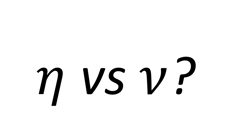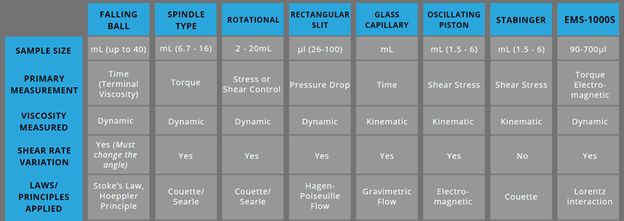Viscosity is a fluids resistance to flow. While that seems straight forward, viscosity is complex and often confusing concept. Add on to the confusion the different types of viscosity – dynamic, kinematic, steady sheer, relative, extensional – and you may find yourself asking: “What is the difference and what type of viscosity should I be measuring?”
To determine the viscosity you should be measuring for your sample it’s important to first and foremost understand what the different types of viscosity are.
- Dynamic (absolute) viscosity – the measurement of the fluid’s internal resistance to flow when force is applied
- Kinematic viscosity – refers to the ratio of dynamic viscosity to density, or a measurement of the viscosity of a fluid in motion
- Steady shear (apparent) viscosity – refers to the relationship between viscosity and shear rate, more specifically the shear stress applied to a fluid divided by the shear rate.
- Relative viscosity – refers to the ratio of the viscosity of a solution to the viscosity of the solvent used
- Extensional viscosity - the resistance of a fluid to extensional flow (flow through a field involving a change in cross-sectional area)
So, we have the different viscosities defined, but what does it all really mean?
Dynamic viscosity will help you to interpret the interaction between molecules in terms of mechanical stress whereas kinematic viscosity is more convenient when working to determine fluid motion ad velocity field. Because dynamic viscosity refers to resistance to flow, while kinematic viscosity relates that resistance to density, two fluids with the same dynamic viscosities can have very different kinematic viscosities depending on density and vice versa. Dynamic viscosity is applicable when working to determine the effect that formulation changes have in regards of molecular interaction and viscosity, for example when formulation biopharmaceuticals. Kinematic viscosity has been the standard in oil industries. Steady shear viscosity does not change when measuring Newtonian fluids, but is directly affected by shear rate of non-Newtonian fluids (Shear Thinning or Thickening or the deformation history for Thixotropic fluid). Relative viscosity is important when measuring viscosity of non-Newtonian fluids, specifically polymers - higher molar mass means higher viscosity in the polymer.
Steady shear viscosity does not change when measuring Newtonian fluids, but is directly affected by shear rate of non-Newtonian fluids (Shear Thinning or Thickening or the deformation history for Thixotropic fluid). Relative viscosity is important when measuring viscosity of non-Newtonian fluids, specifically polymers - higher molar mass means higher viscosity in the polymer.![]() Extensional viscosity is relevant when measuring any flow field involving a change in cross-sectional area. Therefore, extensional viscosity is a fundamental parameter in many industrial processes. Extensional deformation and extensional shearing have a significant impact on certain industrial processes, such as fiber spinning, paint rolling, roll coating, inkjet printing, spraying, electrospinning, enhanced oil recovery, drag reduction, and food processing.
Extensional viscosity is relevant when measuring any flow field involving a change in cross-sectional area. Therefore, extensional viscosity is a fundamental parameter in many industrial processes. Extensional deformation and extensional shearing have a significant impact on certain industrial processes, such as fiber spinning, paint rolling, roll coating, inkjet printing, spraying, electrospinning, enhanced oil recovery, drag reduction, and food processing.
Now that we have established the different types of viscosity and when to measure each, the last important piece of the viscosity puzzle is to determine what viscometer is best to use for measuring your sample. Viscosity can be calculated using various methods and there are numerous viscometers on the market today, but not all viscometers are made alike. Many viscometers on the market today are only capable of accurately measuring viscosity of Newtonian fluids, while most fluids are non-Newtonian. And, often only approximate the apparent properties of fluids, failing to quantify the absolute or true viscosity, which is one of the most important parameters in the development and modeling of applications that involve fluid flow.

RheoSense viscometers are powered by our patented VROC® (Viscometer-Rheometer-on-a-Chip) technology. VROC combines microfluidic and MEMS (Micro-Electro-Mechanical Systems) technologies to measure dynamic viscosity over a wide dynamic range of operation. With VROC viscometers you are able to control shear rates, providing accurate and reliable dynamic viscosity measurements. When using VROC technology, steady shear flow is measured along a uniform channel while extensional viscosity is measured using a flow channel that contains a hyperbolic expansion and contraction to introduce extensional flow.
Written By: Eden Reid, RheoSense Senior Marketing Associate





